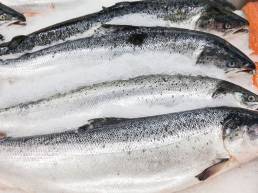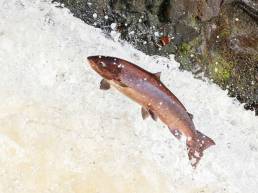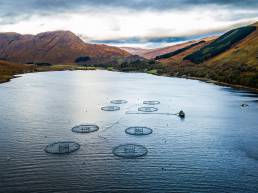In recent months E.F.S. has received many questions about oxidation: ‘How does it work?’, ‘Which antioxidants does E.F.S. use in its oils?’, ‘What happens if the oil is not stored properly?’. We will clarify these questions for you in this post.
What is oxidation?
Oxidation is a chemical process, also known as redox reaction, in which the reducing agent donates electrons to another substance called oxidising agent. A very well known form of oxidation is the rusting of iron (Fe2+ —> Fe3++ e–), during which the iron donates an electron resulting in oxidation/rust. Fats, such as salmon oil can also oxidise. Due to this chemical process (salmon) oil/fat can become rancid. Overoxidised salmon oil/fat is no longer suitable for use in feed. This process can be postponed by antioxidants, hence extending the shelf life of the product.
Oxidation
Oxygen induces hydrolysis of fatty acids, causing fatty acids to detach from glycerol. These detached fatty acids may continue to oxidise as follows: By means of oxygen the free fatty acids are oxidised into peroxides, which are degraded into, among others, radicals. Radicals (e.g. free oxygen) are molecules or atoms that lack an electron and ‘steal’ these from another molecule. In turn these radicals react with other free fatty acids, causing the process to repeat itself and triggering a chain reaction. As the reaction keeps repeating itself fat/oil becomes rancid and is no longer suitable for use. Heating or exposure to uv-light or air can accelerate the chain reaction. Oxidised fat can be identified by its distinctive rancid smell. In order to prevent this an anti-oxidant can be added to fat. An antioxidant is able to scavenge free radicals, hence preventing oxidation and a subsequent chain reaction.
Salmon oil
The salmon oils from E.F.S. are fats with a high content of high-quality unsaturated fatty acids. Unsaturated fatty acids are more susceptible to hydrolysis and therefore more susceptible to oxidation. In order to prevent oxidation, all E.F.S. salmon oils are protected with an antioxidant.
Besides added antioxidants, salmon oil also naturally contains an antioxidant, i.e. astaxanthin. This natural antioxidant already offers a natural form of protection during salmon oil production. Astaxanthin gives salmon oil its distinctive colour (reddish brown) as well. After production, extra antioxidant is added as soon as possible to give salmon oil long-term protection.
The E.F.S. portfolio contains salmon oils from different origins and they are protected by various antioxidants. The antioxidants used are presented in the table below. Scottish salmon oil comes in two varieties, namely with BHA/BHT or with natural antioxidants. The natural antioxidants consist of various tocopherols (vitamin E).
| Salmon oil | Anti-oxidants | (mg/kg) |
| Scottish salmon oil | BHT | 500 |
| Scottish salmon oil | Natural Antioxidants | 375 |
| Norwegian Salmon oil | BHA | 100 |
| Propylegallate | 10 | |
| E.F.S. Scottish fish oil | BHA | 50 |
| BHT | 150 | |
| Latvian salmon oil | BHA | 100 |
| BHT | 500 |
Table 1. Anti-oxidants per salmon oil
How to measure oxidation
Different methods are used to reflect the oxidation sequence. The most frequently used method is the peroxide value (PV), which measures the peroxide content. This is the most widely used method to reflect the level of oxidation in fresh oil. Its target value is <10 meq/kg.
Another oxidation assessment method is the anisidine value. This method measures aldehydes (peroxide degradation products). These aldehydes give oxidised oils/fats their distinctive rancid smell. Its target value is <30 meq/kg. The totox value is determined by multiplying the peroxide value by two and adding the anisdine value to this (totox = AV + 2*PV). The totox value provides a complete picture of the level of oxidation in fats. The iodine value is also known as a method to reflect oxidation, however, it only reflects the number of double bonds which reflects the susceptibility of fat to oxidation.
Storage & processing
In order to give the oil maximum protection it is important to process and store salmon oil correctly. Salmon oil requires protection from external influences (direct sunlight, high temperatures and oxygen) and it is im portant not to allow any contamination in the storage tank or IBC. This is why E.F.S. recommends keeping salmon oil packaging closed as much as possible, draining IBC’s from the bottom part and refraining from using an agitator in the tank. Also salmon oil does not require heated storage. Salmon oil remains liquid down to -10° Celcius!
Do you have any further questions? Please contact E.F.S.
You may also like
Salmon oil for horses?
August 15, 2019
A common phrase is; ‘Horses are herbivores, why should we feed them salmon oil?’. E.F.S. believes this is mainly due to unfamiliarity in the horse farming sector. From a scientific point of view there are no impediments…
Salmon oil and the facts
January 11, 2019
You may have heard or read this through advertising channels: `Are plants the new cows?’. This widely used slogan by a major consumer goods supplier from the Benelux responds to the current trend of eating more plant…
Salmon oil: vegetarian salmon and alternatives
May 19, 2017
Salmon oil is a widely used oil of which 99% is derived from farmed salmon. Its omega-3 fatty acids have positive health effects. Most of the retail business, with the exception of a few suppliers, only has access to…
Salmon oil: pricing and EPA/DHA content
July 12, 2016
In this newsletter we would like to provide some insight as to how pricing works. Firstly, the purchase cost of salmon oil depends on the fish quota and the market situation; it also fluctuates with world market prices.…
Salmon oil and facts
March 1, 2016
Even as early as the 1920s it was already known that certain fatty acids are essential to the good health and growth of animals. Later research showed that one of these essential fatty acids is omega-3.
The plain naked truth on salmon oil
October 6, 2012
There are many stories circulating in the market about salmon oil. In order to bring some clarity to this matter, we focus on the facts pertaining to salmon oil in this article. This applies to all fresh salmon oil.









